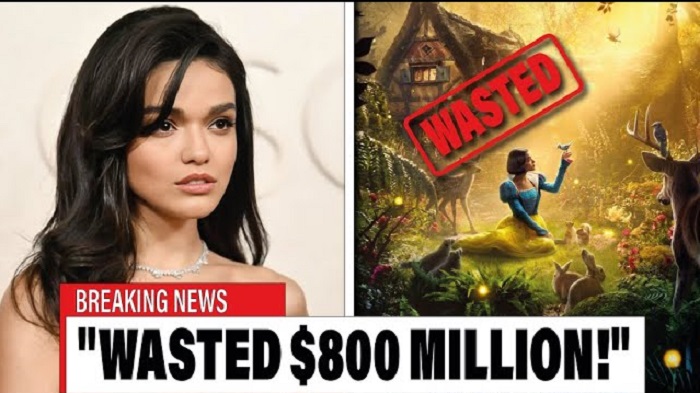Disney’s $800 Million Snow White Catastrophe Crumbles Its Fairy Tale Legacy
Disney, the legendary architect of fairy tale magic, is grappling with a monumental disaster as its live-action Snow White remake has imploded, costing an estimated $800 million and tarnishing the studio’s storied legacy. Branded as a catastrophic misstep, the film’s failure has unleashed a torrent of criticism from fans, investors, and industry watchers, with social media platforms like X ablaze with claims that Disney has betrayed its heritage. From spiraling budgets to divisive creative decisions, this flop has exposed vulnerabilities in Disney’s remake empire. What led to this historic collapse, and how has it shaken the House of Mouse? Let’s dive into the Snow White debacle, its devastating repercussions, and why this scandal has ignited such widespread outrage.

The Snow White Collapse: A Financial Abyss
Launched on March 21, 2025, Disney’s live-action Snow White, directed by Marc Webb, aimed to reimagine the 1937 animated masterpiece for a new era. Starring Rachel Zegler as the empowered princess, Gal Gadot as the Evil Queen, and Andrew Burnap in a reimagined male role, the film promised a bold feminist narrative, sidelining romance for leadership. Backed by new songs from Benj Pasek and Justin Paul, Disney positioned it as a successor to blockbusters like The Lion King ($1.6 billion) and Aladdin ($1 billion).
Instead, it became a financial nightmare. Production costs soared to $370 million, driven by COVID-19 delays, Hollywood strikes, and a set fire. Marketing added $100–$130 million, bringing the total spend to roughly $500 million. To break even, the film needed $625–$700 million globally, but by mid-April 2025, it had grossed only $182.4 million worldwide, including $83 million domestically. Analysts estimate losses of $400–$500 million, with viral X posts inflating the figure to $800 million by factoring in lost revenue projections. This dwarfs previous Disney flops like Mulan (2020, $69.9 million vs. $200 million budget) and Dumbo (2019, $283.8 million projected), cementing Snow White as the studio’s costliest misfire.
The box office trajectory was brutal: a $42.2 million domestic opening weekend, followed by a 66% second-weekend plunge—the steepest for any Disney live-action remake. By week four, it dropped from 1,845 theaters, overtaken by A Minecraft Movie’s $720 million global run. Critics gave it a 40% Rotten Tomatoes score, praising Zegler but panning the CGI dwarfs and uneven story, while a B+ CinemaScore signaled lukewarm audience approval. The $800 million narrative, though partly speculative, captures the magnitude of this financial and cultural failure.
The Fatal Errors Behind the Flop
The Snow White disaster stemmed from a cascade of miscalculations that turned a fairy tale into a cautionary tale:
Polarizing Creative Decisions: Disney’s choice to replace the seven dwarfs with CGI “magical creatures” after Peter Dinklage’s 2022 criticism of stereotyping sparked outrage. Dwarf actors, denied roles, protested outside Disney Studios, arguing the decision erased their visibility. The CGI dwarfs, criticized for retaining cartoonish traits, pleased neither traditionalists nor advocates for authentic representation. The feminist storyline, with Snow White as a revolutionary leader, was lauded by some but alienated fans expecting a faithful adaptation.
Rachel Zegler’s Controversial Spotlight: Zegler’s casting as a Latina Snow White drew racist attacks from those fixated on the “skin as white as snow” description. Her 2022 D23 remarks, labeling the original film “weird” and de-emphasizing romance, fueled backlash. A 2024 pro-Palestine tweet intensified the divide, reportedly creating friction with Gadot and prompting Disney to tighten oversight of her social media. Though Zegler’s performance shone, her public image became a lightning rod, unfairly amplifying the film’s woes.
Budgetary Mismanagement: The $370 million production budget, swollen by reshoots, delays, and CGI-heavy post-production, was a gamble that didn’t pay off. The set fire and strike disruptions added millions, while lavish marketing failed to spark interest. Reports suggest poor oversight allowed costs to spiral, with industry voices questioning the allocation of funds on a project already facing public skepticism.
Cultural Misalignment: Disney’s push for inclusivity and modernization clashed with audience expectations. The film’s progressive narrative struggled to connect with progressive viewers while antagonizing traditionalists. A Middle Eastern ban over Zegler’s political stance curtailed its global reach, and the production’s 4,258-tonne carbon footprint drew environmental criticism, clashing with Disney’s green initiatives.
These errors, set against a crowded remake market and a polarized cultural landscape, doomed Snow White to failure, transforming a beloved classic into a symbol of hubris.
A Legacy in Tatters?
The claim that Snow White “destroyed Disney’s legacy” surfaced in X posts around April 18, 2025, with users decrying the $800 million loss as a betrayal of the 1937 original—the studio’s first feature film and a cultural milestone. While the rhetoric is dramatic, the flop has undeniably bruised Disney’s reputation. The animated Snow White set the standard for storytelling and innovation, and its live-action counterpart’s failure has been framed as a desecration of that heritage.
Financially, Disney can weather the storm. Its diversified empire—theme parks, Disney+ with 150 million subscribers, and hits like A Minecraft Movie—provides a buffer. However, the reputational damage is significant. The Snow White fiasco has fueled perceptions that Disney’s remake formula is faltering, with recent underperformers like The Little Mermaid ($570 million vs. high expectations) and Mufasa: The Lion King ($718 million but culturally underwhelming) signaling a trend. The decision to pause the live-action Tangled remake reflects a strategic pivot, with Disney eyeing lower-budget projects or non-princess stories to reduce risk.
Culturally, Snow White has become a flashpoint in the debate over modernizing classics. The CGI dwarf controversy and Zegler’s casting highlight the challenges of balancing diversity with audience expectations. Disney’s attempt to thread the needle satisfied neither side, exposing the perils of navigating culture wars in blockbuster filmmaking.
The Blame Game and Industry Fallout
The Snow White fallout has sparked intense blame-shifting. Zegler has been scapegoated by some, with critics amplifying her comments and activism as reasons for the flop. A now-deleted Instagram post by Jonah Platt, son of producer Marc Platt, accused her of derailing the film, though fans rallied to her defense. Industry voices have called for scrutiny of the budget, pointing to executive mismanagement rather than Zegler’s role. Her performance, lauded by critics, and her 2025 Met Gala invite suggest her career remains resilient.
CEO Bob Iger, back at Disney’s helm since 2022, faces heightened scrutiny. While rumors of him fleeing the country were debunked, the Snow White loss—following flops like Lightyear ($226 million vs. $200 million) and Haunted Mansion ($117 million vs. $157 million)—has intensified pressure. Iger’s contract runs through 2026, and his leadership has weathered crises before, but this debacle tests his ability to steer Disney through a turbulent era.
Disney’s Path Forward
The Snow White failure has forced Disney to reassess its remake strategy. The studio may shift toward sequels like Toy Story 5 or original stories with tighter budgets, ideally under $150 million. Disney+ and VOD releases could offset some losses, but the theatrical flop underscores the need for better audience alignment. Environmental accountability is also critical, with Snow White’s carbon footprint prompting calls for greener productions.
For Iger, rebuilding trust is paramount. His focus on quality over quantity, as hinted in recent earnings calls, aims to restore Disney’s cinematic dominance. The Snow White saga, while a low point, is unlikely to derail the company’s broader success, but it serves as a warning against overambition in a volatile market.
Why This Disaster Grips the World
The Snow White catastrophe, with its $800 million price tag, has seized attention because it strikes at Disney’s core identity as a beacon of enchantment. The loss, even if exaggerated, symbolizes a fall from grace, amplified by X posts mourning the “crumbling” of a fairy tale legacy. The controversies—Zegler’s vilification, CGI dwarfs, runaway costs—reflect deeper tensions over representation, corporate accountability, and the evolution of storytelling. As Disney navigates the wreckage, this historic flop proves that even the mightiest kingdoms can falter—Find Out Why This Disaster Is Fueling Fury!





